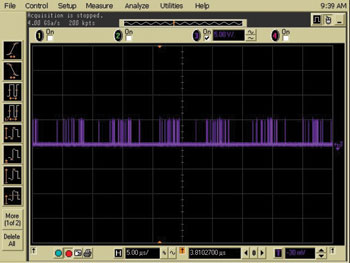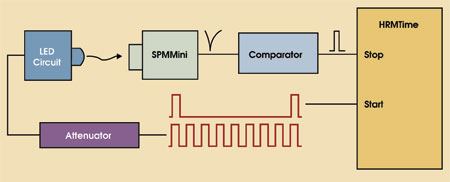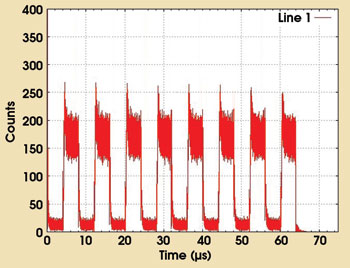The combination of a silicon photon multiplier detector and a sub-100-ps high-resolution timing module detects photons from a modulated, extremely low level light source. The technique has applications in light-starved fields such as lidar.
Steven J. Buckley and Dr. Andrew G. Stewart, SensL, Cork, Ireland
Low-light applications such as light detection and ranging (lidar), cell imaging, biodiagnostics, and particle detection and sorting require single-photon sensitivity and very fine timing resolution. Until now, this has not been possible with large-area silicon photon-counting devices, but a new generation of silicon photomultiplier detectors exhibits characteristics that produce the appropriate sensitivity and resolution. SensL, the low-light-sensing company based in Cork, Ireland, is using its silicon photomultiplier detector with its HRMTime timing module to detect photons from a modulated, extremely low level light source.
One major challenge in using photomultiplier tubes in low-light applications is the variation of the gain of the detector in response to single-photon events. This gain variation leads to a complicated output signal amplitude that typically necessitates complex electronics such as constant fraction discriminators to carry out the time-resolution analysis. Constant fraction discriminator technology precisely times the arrival of a signal with a varying pulse height, which is a typical response from photomultiplier tubes to low-light signals at the photon-counting level.
In contrast, the new generation of silicon photomultiplier detectors exhibits uniform gain in response to single-photon events and yields a low dark count rate when cooled. This combination of characteristics means that a large-area detector measuring 1 mm2 combines photon counting with precision timing. Its constant gain provides an output signal of consistent rise time, fall time and amplitude, so that simple level-thresholding comparator circuitry is sufficient for its time resolution. This provides a significant advantage over photomultiplier tube detector-based systems with respect to reduced complexity and higher integration.
A photon-counting demonstration
The SPMMini consists of a SensL 1-mm2 silicon photomultiplier connected to a high-gain amplifier board, with a cooling board to reduce the noise level to allow single-photon detection. The HRMTime module achieves sub-100-ps timing resolution. The silicon photomultiplier produces single-level Geiger pulses of about 120 mV, corresponding to single-photon events, and the pulses have an onset time of 6 ns and a recovery time of 30 ns. The output of the high-gain amplifier board is sent to a level-thresholding comparator circuit, with its threshold set to approximately 60 mV, or half the peak height of the single-level Geiger pulses. The resultant output from the comparator circuit is connected to the “stop” terminal of the SensL Time. The width of the comparator pulses is approximately 12 ns for a single Geiger pulse from the silicon photomultiplier.

Figure 1. This oscilloscope trace shows the typical output pulses from the comparator in response to single-photon events on the SPMMini. The vertical axis shows pulse amplitude with a scale of 5 V per division, and the horizontal axis shows time with 5 μs per division.
In this experiment, an LED driven by a clock pulse with a period of 8 μs and a 50 per cent duty cycle provides the optical signal. The LED switches on for 4 μs during each clock period. The LED signal must be reduced before passing into an integrating sphere with an SPMMini detector attached. The level of attenuation creates a probability of less than 1 that a photon will arrive during each Geiger pulse, ensuring that multiple photon events are infrequent, so no photons are overlooked in the subsequent histogram plot.
The pulse stream from the comparator feeds into the stop input of the HRMTime module, while the “start” input connects to a clock signal in phase with the 8-μs signal driving the LED, but at one-eighth its frequency. Thus, a start pulse occurs every eight cycles of the LED driver signal.

Figure 2. This schematic illustrates the experimental setup employed in combining a SensL SPMMini detector with the company’s HRMTime timing module.
Using the HRMTime in multiscalar/counter histogram mode with a time-bin resolution of 27 ps, the module waits for a start pulse (low-high transition) and records all stop transitions by incrementing time bins in the memory. The arrival of a new start pulse resets the timer and repeats the process. By running this procedure continuously, the HRMTime module builds up a histogram of the stop events that have occurred since the most recent start signal. Proprietary software generates a histogram output and provides data acquisition and readout to a PC.

Figure 3. SensL software generates a histogram output showing the photon-counting results over eight LED switching cycles.
SensL has successfully demonstrated photon counting using an SPMMini detector module and an HRMTime sub-100-ps timing module. The company used a level-thresholding comparator rather than a conventional constant fraction discriminator. The experiment employed very simple interface electronics between the SPMMini and HRMTime modules to illustrate the capability of photon counting and time stamping in low-light applications such as lidar.
Contact: Steven J. Buckley, SensL; fax: +353 21 435 0447; e-mail: [email protected].